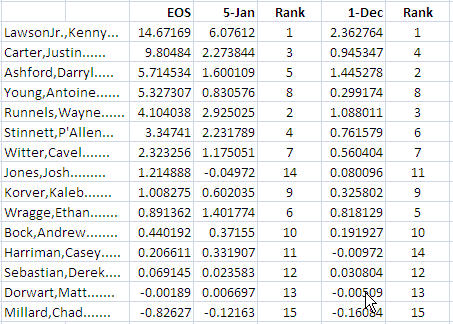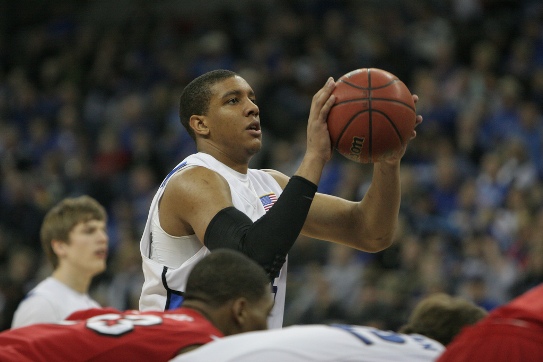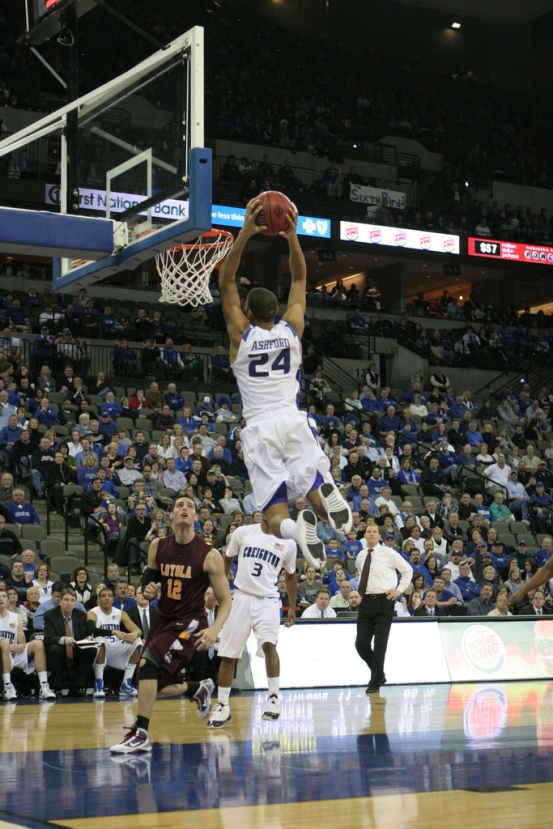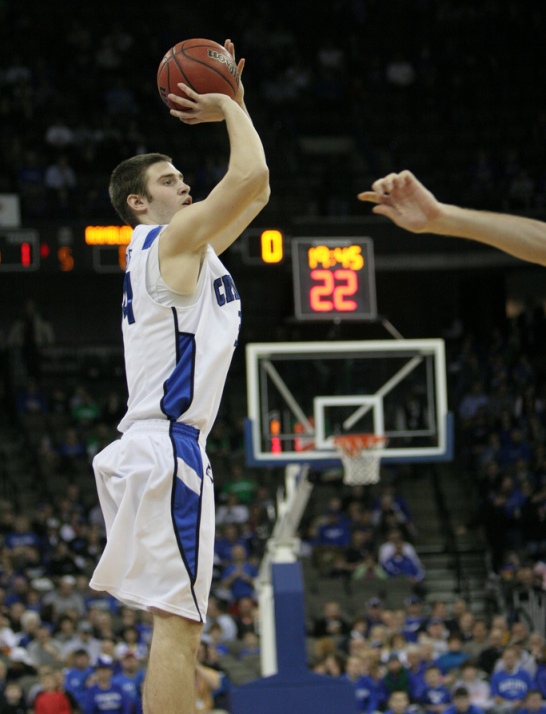As Butler and Duke ended an exciting basketball season in Monday’s National Championship game, Creighton fans watching in Omaha and across the country had to ask themselves when the Bluejays will reach the NCAA Tournament again, much less morph into the next great underdog to advance through the field of 65 or 96 or how many teams will participate in the Big Dance moving forward.
With the closing notes of “One Shining Moment” fans’ attention turns to what next year will bring. Otter gave a great set of items and players to look forward to going into next season. But for the geek in us, people like me take a look at the numbers to tell us the story.
WBR published two Win Score analyses of the Creighton Bluejays men’s basketball team this season: the first analysis occurred after just six games, while the second was at the halfway point. The purpose? To cast a statistical conclusion about the players’ individual effectiveness. The numbers analyzed don’t lie.
Heading into the 2010-11 season, this will be Kenny Lawson’s team to carry on his shoulders. The senior-to-be raised his game even more toward the end of the season, including adding the 3-pointer to his repertoire. The table below ranks the Bluejays based on Win Score wins produced, and includes their position at the time of the previous two analyses.
Antoine Young: Being the starting point guard for Creighton can’t be easy. A select group of players manned the point for Dana Altman for more than a decade; stalwarts such as Ryan Sears, Tyler McKinney, and Josh Dotzler. And although Young backed up Dotzler at times last season, it took the sophomore what seemed to be about half this season to get comfortable and adjust his game to the role of Altman’s floor general.
This transformation is apparent in his Win Score. Through half the season, Young was at the bottom half of the Win Score rankings. He started taking a little more of a scoring mentality at that point, which coincided with an increase in his assist-to-turnover ratio. A season-high 22 points at Southern Illinois and a 12 point, 8 assist night against Bradley on Senior Day were just two examples of how far Young evolved his game from November to season’s end.
Kenny Lawson: The second team All-MVC pick continues to be consistent for Creighton. As the season went along, Lawson took this consistency to a new level. He disappeared for stretches of games; sometimes because a team focused most of its defensive attention on stopping him. But his Win Score reflects highly on his overall contributions during his minutes on the court. Simply put, when the Jays won, he was usually a big reason for the victory.
Lawson led the Jays in almost every major statistical category — points, field goals made, field goals attempted, field goal percentage, free throws made, free throws attempted, rebounds, and blocks. In fact, Lawson, based on Win Score, has been the most outstanding Creighton contributor for the past two seasons. He led the way at the end of last season and built on that success for this year. As Lawson heads into his senior season, his continued hard work and natural ability provide him another opportunity to improve his output and the team’s fortunes. Adding a 3-point shot to his game doesn’t hurt either. Opponents will likely find Lawson hard to defend with just one man, especially if he and Greg Echenique share court time.
Justin Carter: Although Carter suffered a knee injury in November that slowed the start to his season, he was still an important contributor when he stepped on the court. His Win Score steadily improved at each point of the season; he started at fourth and moved to second by March. In three of his last four games, Carter averaged more than 10 rebounds per contest and was consistently a scoring threat all season. The Bluejays and their fans will no doubt miss Carter’s all-around effort next season.
Darryl Ashford: Ashford is a prime example of the up and down season Creighton had. He started out the season hot in many facets of the game before teams were able to see more tape of his play. That sort of put Ashford into a mid-season slump as teams learned how to defend him. Ashford played well over 20 minutes in 15 of the first 21 games. But after missing the road game at Drake in late January due to a death in the family, Ashford played more than 20 minutes only once. Still, his minutes proved effective and efficient, evidenced by an improved Win Score down the stretch of the season.
Ethan Wragge: Wragge is one of the players I enjoyed watching most this past season. He was deadly from long range; I almost thought every time he fired the shot would fall. He even earned himself a spot in the starting line-up during the season’s last 7 games. But can Wragge move from a one-dimensional threat and expand his game?
As much as I like seeing him on the court, might he be better coming off the bench? The Win Score somewhat supports that conclusion. From the middle of the season on Wragge’s Win Score actually went down, which was also the time that he became a starter. That probably had more to do with the number of fouls he committed in limited minutes, his inability to get to the free throw line, and his lack of rebounds and assists. Many times those fouls game because he was out of position.
Wragge hit a 3-pointer in his last 21 consecutive games, but it will be interesting to watch his development and determine if there is more to his game than just draining long distance jumpers. His freshman season statistics offer support to projections that he could blossom into a Kyle Korver-type player. But Wragge will be challenged this offseason to find ways to create shots and make an impact on defense.
Cavel Witter: Witter has been an interesting case over the past couple years, as he has stayed at about the same point in win score rankings throughout his career. He started seventh this season, stayed seventh in the middle, and finished up in that same spot. With as many minutes he played as the backup point guard and at times shooting guard, you probably would have expected him to be toward the top of the list. But compare the assist-to-turnover ratio between Witter and Young. They both had about the same number of turnovers, but Young had more than twice as many assists. Witter and Young were even in many statistical categories, but this ratio was the big factor in Young’s rise throughout the season and Witter staying at the same Win Score.
Looking to the future
Based on Win Score, the Bluejays will return 5 of their top 6 players next season, which should be a bonus based on last year’s end of the season Win Score. The Win Score says CU’s starting lineup heading into next season would be:
PG: Antoine Young
SG: Josh Jones
SF: Darryl Ashford
PF: Wayne Runnels
C: Kenny Lawson
But that projection doesn’t include suspended guard P’Allen Stinnett. If the senior-to-be returns to Altman’s team, it is unknown whether he would regain his starting position and be poised to serve as a weapon off the bench. Bringing Stinnett and Wragge off the pine would inject instant offense into the lineup. Add the impending introduction of Echenique to the rotation in mid December, and the Bluejays will again produce a rather talented core group of players.
The question remains: How will Altman bring the team together on the court and achieve what has been out of reach for the past three seasons — a trip to the NCAA Tournament? What line-up will give Altman and the Bluejays the best chance to win a Valley title?
What does your depth chart look like for next season?




